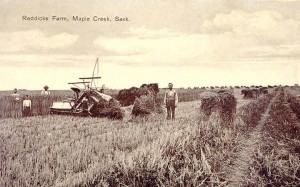It is hard to imagine Canada today without some of its most iconic agricultural landscapes; wheat and soy fields that sweep across the prairies, fruit orchards laden with fruit for domestic use and export, the famous PEI potato farms, and more recently, vineyards that are making world-class wines. Likewise, it is difficult to image this country with the dog as its only domesticated animal, especially with pork being one of our top exported agricultural goods.
With Canada today such an agricultural power house, exporting $40.303 billion in 2011 alone, it is sometimes surprising to think that most of these plants and animals didn’t exist in our country or on this continent before the arrival of European settlers. The exchange of natural materials from previously isolated areas is known as The Columbian Exchange. The term was coined by Alfred W. Crosby in his book The Columbian Exchange: Biological and Cultural Consequences of 1492, published by Greenwood Publishing Group in 1972, and while Crosby explored this idea in ground breaking ways, he was not the first to examine the historical record for instances of these kinds of exchanges and their consequences.
Appearing in the Canadian Historical Review vol 16, no 4 (1935), The First Introduction of European Plants and Animals into Canada examines how and when plants and animals were brought to Canada from Europe and the nature of their use.

Comments on this entry are closed.